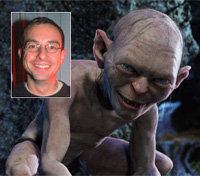Henrik Wann Jensen, Associate Professor in Computer Graphics, winner of an Oscar and “Master of Light”
 Why is the sky blue? Why is the sunset red? And how do you simulate these everyday occurrences in computer graphics?
Why is the sky blue? Why is the sunset red? And how do you simulate these everyday occurrences in computer graphics?A fascination of fractal geometry and a Commodore 64 put Henrik Wann Jensen on a career path in computer graphics. A career that got him involved in blockbuster movies such as Avatar and Lord of The Rings, landed him an Oscar and made him Associate Professor in the Computer Graphics Laboratory at University of California. "My interest for computer graphics started back in school with a Commodore 64. When fractals took off I found it beautiful and very exciting," Henrik Wann Jensen says.
Henrik Wann Jensen started to use BASIC and Assembler to create his own fractals on his Commodore 64 and soon became interested in making graphics of more everyday objects. He realized he needed a way to emulate how nature unfolds its beauty. "By nature, I am very curious. Why do things look the way they do? I ask the kind of questions small kids ask. Why is grass green? Why is the sky blue? Why does milk look the way it does? I am trying to understand it in a way that makes it possible to simulate nature," Henrik Wann Jensen explains and he adds that his approach really is quite simple.Well, maybe, but if you try to read his paper "A Practical Model for Subsurface Light Transport" which introduces the groundbreaking bidirectional surface scattering distribution function (BSSRFD) instead of the old bidirectional reflectance distribution function (BRDF)-technique it is not entirely simple. "No, you are right. It becomes quite mathematical when it has to be modeled for computers," he laughs: "I have specialized in understanding the underlying mathematics that makes it work." But Henrik Wann Jensen has the gift of explaining the complex mathematical models in simple terms. "With BRDF the light you simulate is reflected directly from a surface. It gives a hard feel, a kind of plastic feel for a human face. With BSSRDF some of the light is absorbed by the skin. It makes it possible for the light to move through the skin which creates effects like seeing the light shining through an ear when it is lit from behind. It gives the skin a more soft and natural appearance."
It was the work on the BSSRDF that landed him an Academy Award for technical achievement in 2004. Before his research and work on the BSSRDF he developed the Photon mapping technique during his Ph. D. work. "Photon mapping computes how light is moving around in a room. It is a computer simulation of how photons are moving around," Henrik Wann Jensen explains. So, in keeping with a Tolkien-esque terminology to honor his work on Gollum in Lord of The Rings, he could be called Master of Light. "Yes, you could say that," he laughs and adds: "I am trying to reverse the nature of engineering. How does nature behave when different objects are illuminated. What happens with the light, how is it reflected? I am trying to understand it, so that I can simulate it on a computer in a way that makes people feel it is the real objects they are looking at."
Fractals made Henrik Wann Jensen interested in computer graphics. Here is the famous Mandelbrot-set
Of course you know why the sky is blue and the sunset is red, but the JAOO-team needed a little brush-up:
Of course you know why the sky is blue and the sunset is red, but the JAOO-team needed a little brush-up:
Why is the sky blue? As light moves through the atmosphere, most of the longer wavelengths pass straight through. Little of the red, orange and yellow light is affected by the air. However, much of the shorter wavelength light is absorbed by the gas molecules. The absorbed blue light is then radiated in different directions. It gets scattered all around the sky. Since you see the blue light from everywhere overhead, the sky looks blue.
Why is the sunset red? As the sun begins to set, the light must travel farther through the atmosphere before it gets to you. More of the light is reflected and scattered. The color of the sun itself appears to change, first to orange and then to red. This is because even more of the short wavelength blues and greens are now scattered. Only the longer wavelengths are left in the direct beam that reaches your eyes.
http://www.sciencemadesimple.com/sky_blue.html
http://www.sciencemadesimple.com/sky_blue.html
